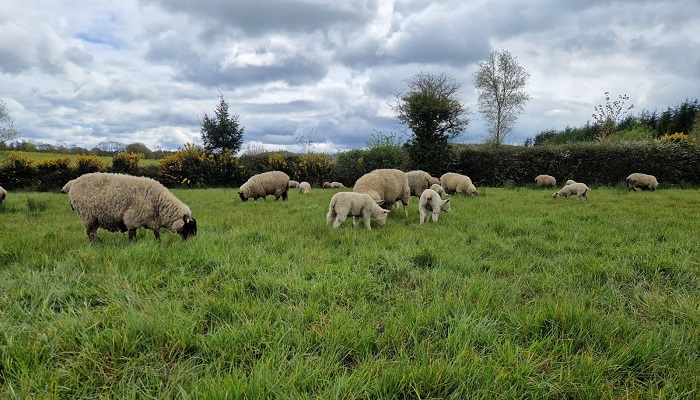08 April 2025
Looking back to move forward – time to review lambing performance

As the 2025 lambing season draws to an end, Head of Sheep Knowledge Transfer at Teagasc, Michael Gottstein highlights three areas farmers need to review that will directly impact productivity and profitability for the year ahead.
This spring has been kind to sheep farmers. If we think back to last year and even 2023, the weather during the peak lambing months of March and April were very different to what we have experienced this year. In fact, apart from a shortage of grass growth, we have had almost perfect conditions for lambing and turning out ewes with young lambs.
The following review outlines key areas for examination, so that this information can be used to improve performance and lamb survival in the coming years.
Ewe health and fertility
The number of ewes to the ram and the date of service are key indicators in determining lambing success. Examine the scanning data from last December or January to provide an insight into ewe fertility.
Ewe fertility is not just the percentage of ewes that are in lamb or the number of lambs that they are carrying, the lambing spread is also important.
Many sheep farmers work off farm, so having a compact lambing season with >80% of the ewes lambing in the first cycle means that the amount of time off work to lamb ewes can be reduced.
On farms where lambing is slow to start and very drawn out, this can be a sign of ewes that are in poor body condition at mating time or simply that the start of the mating season does not coincide with the ewes’ natural oestrus cycle having kicked into action.
Other targets to keep in mind are as follows:
- Percentage of ewes in lamb: This is the percentage of ewes put to the ram that scan in-lamb. The target here is to have less than 4% of the ewes showing up as barren/dry at scanning time. Larger percentages of barren ewes can point to issues such as suboptimal ewe body condition at mating, infectious agents that cause embryo loss or ram fertility issues.
- Litter size: The money in most Irish sheep farming systems is in selling lambs. We don’t make money from selling wool or milk. Consequently, the more lambs that we have to sell the better. On lowland systems ewes with a single lamb rarely pay their way. The target for lowland production systems should be a minimum of 1.6 lambs reared per ewe to the ram. To achieve this, target we generally need a scan litter size of around 1.8-1.9. There’s room for improvement in many flocks on this front.
Lambing issues and mortality
Analyse the level of lambing intervention and lamb mortality in the flock while it is still fresh in your mind. The lamb mortality figure should encompass every potential lamb lost. This includes embryo loss post scanning, lambs lost inside in ewes that die pre lambing, abortions and lambs that are born dead or die within 48 hours of birth. To make progress on this issue, all sources of lamb loss should be investigated and steps taken to minimise these in future years.
Higher litter size flocks will have a higher mortality percentage because of the higher number of multiple births. Therefore, when comparing mortality across flocks, it is important to keep in mind that for a lower litter size flock (<1.6), the target mortality from scanning should be less than 10%, whereas for higher litter size flock, the target should be to aim for less than 15% mortality from scanning.
Flock health
Some of the key flock health benchmarks are items such as: prolapse levels; lameness levels, the incidence of conditions such as milk fever / twin lamb disease in ewes.
On the lamb side, keep track of mortality post turn out, as well as the incidence of conditions such as watery mouth / E. coli, joint ill in addition to genetic conditions such as tight tendons and in-turned eyelids.
Some flocks suffer relative high incidences of metabolic conditions in ewes (prolapse, twin lamb / milk fever) and these can generally be rectified by looking closely at late pregnancy nutrition and feeding management. From a target point of view, most of these conditions should be rare in the flock. As a general rule, we should be looking at less than one percent of the animals having to be treated for conditions such as prolapse, milk fever and in the case of lambs joint ill or E.Coli / watery mouth. The latter condition in the lambs is generally down to lack of hygiene and colostrum quality.
The most important point in relation to flock health issues is to seek advice from your vet on any issues that are causing mortality or ill thrift. Carrying out laboratory testing to identify the actual cause of issues is always money well spent. Too often I come across flocks that get hit repeatedly with the same problems because they have not correctly identified the cause and taken appropriate steps to eliminate it going forward.
Looking ahead: Continuous improvement
As we close the 2025 lambing season, it’s important to recognise that every lamb lost represents a financial setback. Sheep prices have never been as high, and costs associated with running the farm have also increased dramatically over the years. For that reason, every lamb saved represents an additional €100 – €200 of increased output.
Ultimately, reviewing lambing performance allows farmers to make informed decisions about flock management and implement necessary changes that will ensure improved lambing outcomes in the future.
More from Teagasc Daily: Grass tetany control in ewes
